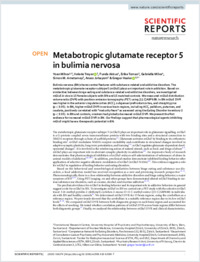Metabotropic glutamate receptor 5 in bulimia nervosa
- Mihov, Yoan Translational Research Center, University Hospital of Psychiatry and Psychotherapy, University of Bern, Bern, Switzerland - Psychiatry Research Unit, University of Fribourg, Chemin du Cardinal-Journet 3, 1752, Villars-sur-Glâne, Switzerland
- Treyer, Valerie Departement of Nuclear Medicine, University Hospital Zürich, University of Zürich, 8091, Zürich, Switzerland
- Akkus, Funda Translational Research Center, University Hospital of Psychiatry and Psychotherapy, University of Bern, Bern, Switzerland
- Toman, Erika Competence Network for Eating Disorders, Forchstrasse 132, 8032, Zürich, Switzerland
- Milos, Gabriella Department of Consultation-Liaison Psychiatry and Psychosomatic Medicine, University Hospital Zürich, Culmannstrasse 8, 8091, Zürich, Switzerland
- Ametamey, Simon M. Center for Radiopharmaceutical Science of ETH, PSI, and USZ, Department of Chemistry and Applied Biosciences of ETH, 8093, Zürich, Switzerland
- Johayem, Anass Departement of Nuclear Medicine, University Hospital Zürich, University of Zürich, 8091, Zürich, Switzerland
- Hasler, Gregor Translational Research Center, University Hospital of Psychiatry and Psychotherapy, University of Bern, Bern, Switzerland - Psychiatry Research Unit, University of Fribourg, Chemin du Cardinal-Journet 3, 1752, Villars-sur-Glâne, Switzerland
-
14.04.2020
Published in:
- Scientific Reports. - 2020, vol. 10, no. 1, p. 6374
English
Bulimia nervosa (BN) shares central features with substance-related and addictive disorders. The metabotropic glutamate receptor subtype 5 (mGlu5) plays an important role in addiction. Based on similarities between binge eating and substance-related and addictive disorders, we investigated mGlu5 in vivo in 15 female subjects with BN and 15 matched controls. We measured mGlu5 distribution volume ratio (DVR) with positron emission tomography (PET) using [11 C]ABP688. In BN mGlu5 DVR was higher in the anterior cingulate cortex (ACC), subgenual prefrontal cortex, and straight gyrus (p < 0.05). In BN, higher mGlu5 DVR in various brain regions, including ACC, pallidum, putamen, and caudate, positively correlated with “maturity fears” as assessed using the Eating Disorder Inventory-2 (p < 0.05). In BN and controls, smokers had globally decreased mGlu5 DVR. We present the first evidence for increased mGlu5 DVR in BN. Our findings suggest that pharmacological agents inhibiting mGlu5 might have a therapeutic potential in BN.
- Faculty
- Faculté des sciences et de médecine
- Department
- Master en médecine
- Language
-
- English
- Classification
- Biological sciences
- License
-
License undefined
- Identifiers
-
- RERO DOC 329471
- DOI 10.1038/s41598-020-63389-7
- Persistent URL
- https://folia.unifr.ch/unifr/documents/308888
Other files
Statistics
Document views: 156
File downloads:
- pdf: 194
- Supplementary material: 147

